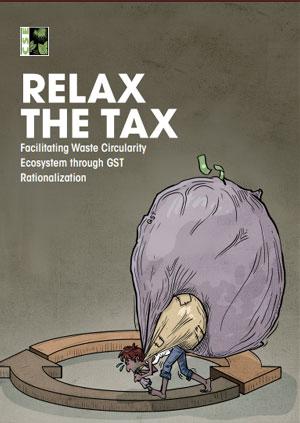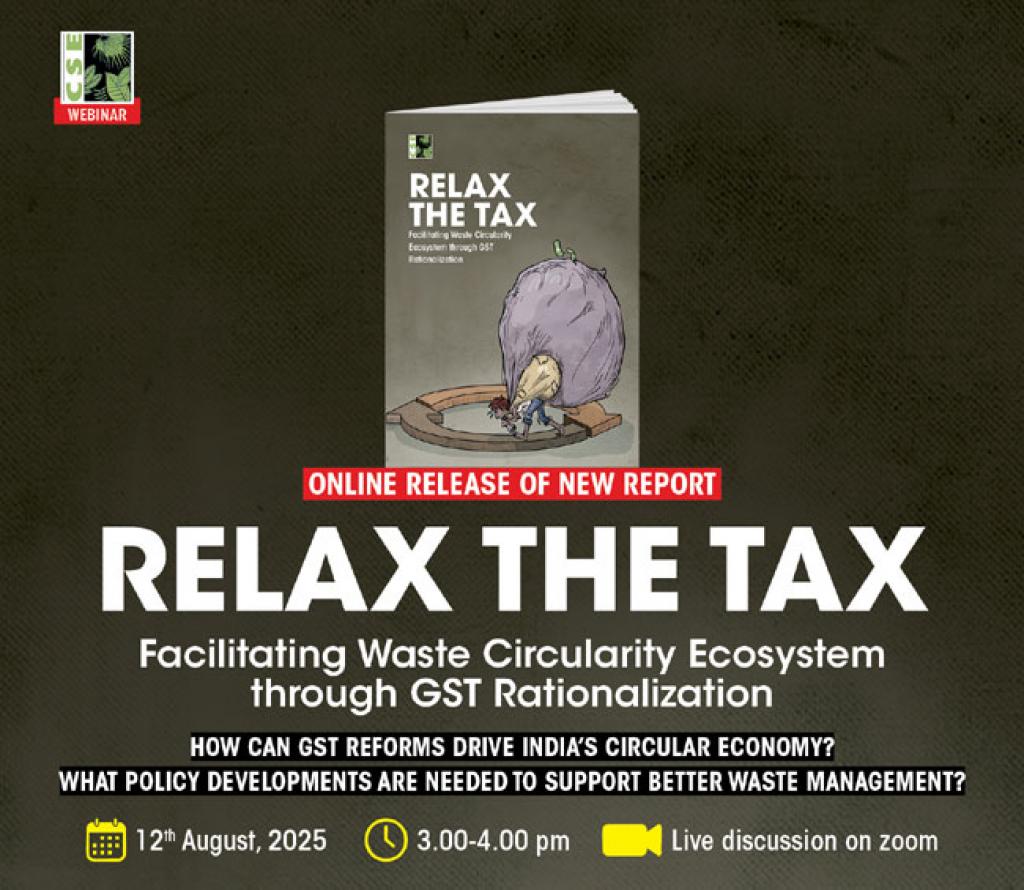New CSE study says urgent reforms in GST regime needed to shore up India’s circular economy and waste recycling sector
Steep 18 per cent GST on waste streams like metal scrap, plastics and e-waste completely counter-productive, proves the study. Calls for bringing the tax down to 5 per cent
GST rationalisation can net Rs 1.8 lakh crore in additional revenue by 2035
Download the copy of the CSE study click here:
Access the proceedings of the online report release click here
New Delhi, August 12, 2025: A new analysis of India’s Goods and Services Tax (GST) regimeby Centre for Science and Environment (CSE) has shown that this much debated taxation structure can garner up to Rs 1.8 lakh crore in additional revenue by 2035 – simply by initiating some basic reforms in the way it deals with solid waste.
“While India is rooting for reuse-recycle of waste and promotion of a circular economy, the existing GST regime could be dumping all that effort into the proverbial ‘wastebin’. For one, the regime does not differentiate between virgin and recycled materials, taxing them equally, which places recycled products at a severe cost disadvantage despite their lower environmental impacts,” says Nivit K Yadav, programme director, industrial pollution unit, CSE.
Yadav was speaking here today at the online release of CSE’s study -- Relax the Tax: Facilitating Waste Circularity Ecosystem through GST Rationalization -- which exposes how the GST system is actually hindering the growth of a circular economy in the country, and also leading to revenue losses.
Among the others who spoke at the release of the study were Dr Sandip Chatterjee, senior advisor, Sustainable Electronics Recycling International (SERI) and former senior director, Union ministry of electronics and information technology; Pranshu Singhal, founder and managing director, Karo Sambhav; Imteyaz Ali, project director, Plastic Sarthak Sanstha; and Subhrajit Goswami, programme officer, industrial pollution unit, CSE.
High GST rates are stifling critical recycling sectors
A steep GST of 18 per cent levied on several crucial waste categories has become an obstacle in the sustainable management of solid waste. Says SubhrajitGoswami of CSE:“Metal scrap, including ferrous and non-ferrous materials essential for secondary steel and aluminum production, faces this high tax rate, making formal transactions economically unviable for small dealers.”
This flies in the face of the National Steel Policy,which aims for 40 per cent of India's steel production to come from scrap by 2030 – the 18 per cent GST on ferrous scrap makes it economically unviable for small dealers to operate formally. A reduced rate would align the fiscal policy with our circular economy objectives, says Goswami.
Similarly, plastic waste, electronic waste and various industrial by-products are subjected to an 18 per cent GST, creating a significant cost burden that pushes operators toward informal, cash-based transactions. Goswamipoints out that this high taxation particularly impacts e-waste recycling, where valuable materials like gold, silver and rare earth elements could generate substantial formal economy revenues if properly incentivised through lower tax rates.
Speaking at the report release, PranshuSinghal of KaroSambhav concurred: “No one actually looks at waste as a resource – they wake up only when both natural resources and waste are taxed at the same rates for them.”
India's waste management sector is dominated by informal operators, who handle up to 90 per cent of certain waste streams like e-waste and metal scrap. According to SERI’s Sandip Chatterjee, “Policies have focused more on the EPR (Extended Producer Responsibility) rules, which manage to cover about 30 per cent of the waste – but the remaining major chunk of waste (70 per cent) is handled by the informal sector.”
The CSE study finds that small dealers who collect scrap cannot afford an 18 per cent GST, so they keep their transactions cash-based and untaxed. This not only deprives the government of revenue, but also distorts the market, as compliant businesses struggle to compete with tax-evading informal operators. In fact, the informal sector dominance results in an estimated Rs 65,000 crore in annual GST losses due to unrecorded transactions. Without interventions, this loss is projected to escalate to Rs86,700 crore by 2035.
The CSE analysis offers another strong motivation for rationalising the GST regime. Millions of informal workers handle hazardous waste like batteries and e-waste without safety gear or fair wages. Formalising their work with social security, better pricing and access to healthcare is not just an economic necessity – it is a moral obligation.
Yadavhighlights the broader implications for India's industrial competitiveness: "Our research shows that the current GST structure is inadvertently penalising the very sectors that could drive India's transition to a circular economy. The 18 per cent tax on e-waste and metal scrap is particularly counterproductive when we're trying to build a robust secondary materials market. By rationalising these rates, we're not just talking about tax reform -- we're talking about unlocking India's potential as a global leader in sustainable manufacturing.”
CSE study advocates a four-pronged strategy for reform
- Phased GST reduction: The study recommends lowering GST rates on critical waste streams -- such as metal scrap, plastics and e-waste -- from 18 per cent to 12 per cent in the short term, with a further reduction to 5 per cent. This would encourage and incentivisecompliance while maintaining revenue neutrality.
- Integration of the informal sector: Even a 50 per cent reduction in informal sector participation, combined with a 12 per cent GST rate, could generate Rs62,384 crore in net revenue by 2035. The report proposes integrating informal workers into government schemesand providing access for them to subsidised loans, healthcare, and pensions.
- EPR-GST integration: To strengthen Extended Producer Responsibility (EPR) compliance, the report suggests linking GST benefits to verified recycling. Producers who meet EPR targets through formal channels could receive tax rebates, creating a self-reinforcing cycle of compliance and transparency.
- NGO and CSO integration for sectoral transformation: The study emphasises the crucial role of non-governmental organisations and civil society organisations in bridging the gap between informal workers and formal systems. NGOs with established networks in waste management communities can facilitate skill development programmes, provide financial literacy training, and help workers access government schemes. CSOs can serve as intermediaries, helping informal operators understand compliance requirements while advocating for their rights and safety standards. This collaborative approach ensures that formalisation doesnot displace existing workers, instead it upgrades their working conditions and economic opportunities through structured support systems.
Goswami, who is the report's lead author, says: "Our analysis proves that the status quo is unsustainable. The government loses double what it collects from the waste sector today -- a deficit that will only worsen. By lowering GST rates and formalising the sector, we can turn this into aRs-1.8 lakh crore opportunity while advancing environmental and social justice. This report provides the roadmap; now we need the political will to implement it."
For more on this, please contact: SUKANYA NAIR, sukanya.nair@cseindia.org, 8816818864
| Report | |
 |
Relax The Tax |
 |
|
Share this article